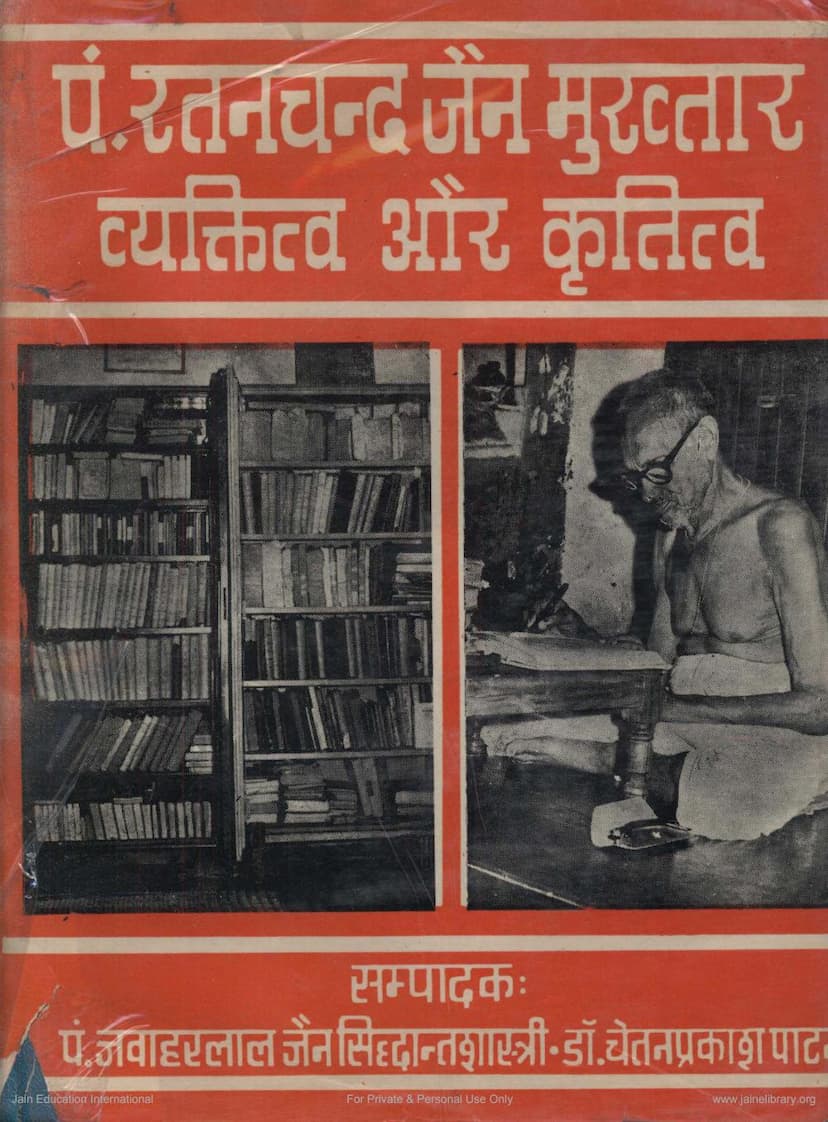Ratanchand Jain Mukhtar Vyaktitva Aur Krutitva Part 1
Added to library: September 2, 2025

Summary
Summary of "Ratanchand Jain Mukhtar: Vyaktitva aur Krutitva Part 1"
This book, compiled and edited by Pandit Jawaharlal Shastri and Dr. Chetanprakash Patni, published by Acharya Shivasagar Digambar Jain Granthamala Rajasthan, is a comprehensive tribute to the life and contributions of Pandit Ratanchand Jain Mukhtar. The work is divided into two main sections: Personality (Vyaktitva) and Works (Krutitva).
Personality (Vyaktitva):
This section delves into various aspects of Pandit Ratanchand Jain Mukhtar's life:
- Life Story (Jeevanvritta): This part likely details his biographical journey, from his birth in Saharanpur, UP, around 1883, to his early education, family life, his initial career as a successful lawyer (Mukhtar), and his eventual renunciation of the legal profession due to ethical concerns. It highlights his transition towards a life dedicated to Jain scriptures and philosophy. His learning journey is emphasized, particularly his self-study in Sanskrit, Prakrit, and Hindi without formal schooling, which is presented as a testament to his intellectual prowess and dedication. His simple lifestyle, adherence to vows, and profound devotion to Jain principles are likely covered. His passing in 1980, at the age of 76, is also mentioned.
- Shadow Images (Chhaya Chhaviyan): This section probably contains rare photographs of Pandit Ratanchand Jain Mukhtar, offering a visual glimpse into his life and personality.
- Blessings (Aashirvachan): This includes blessings and endorsements from prominent Jain scholars, monks, and spiritual leaders who recognized his contributions and intellect. Notable figures like Acharya Kalpa 108 Shri Shrutasagarji Maharaj, Munishri Vardhmansagarji Maharaj, and Aryika Shri Vishuddhamati Mataji have provided their blessings, underscoring the significance of this work.
- Tributes (Shraddhanjali): This part likely contains heartfelt tributes and eulogies from his disciples, admirers, and fellow scholars, reflecting on his impact and legacy.
- Reminiscences (Sansmaran): This section likely features personal anecdotes and memories from individuals who knew Pandit Ratanchand Jain Mukhtar, offering personal insights into his character and interactions.
Works (Krutitva):
This section focuses on Pandit Ratanchand Jain Mukhtar's extensive literary and scholarly contributions, primarily centered around resolving doubts and elucidating Jain principles:
- Shanka-Samadhan (Doubt Resolution): This is presented as the most significant part of his work. The book compiles over 1700 questions posed by scholars and seekers from across Jain literature, spanning all four Anuyogas (canonical divisions):
- Prathamanuyoga: Dealing with historical and narrative aspects of Jainism, including the lives of Tirthankaras, chakravartis, etc.
- Karananuyoga: The most complex section, focusing on Jain cosmology, mathematics, karma theory, and the intricate workings of the universe as described in the scriptures. Pandit Ratanchand Jain Mukhtar is particularly highlighted as an expert in this Anuyoga.
- Charananuyoga: Concerned with conduct, ethics, vows, and the practices of ascetics and lay followers.
- Dravyanuyoga: The philosophical core of Jainism, dealing with the nature of substances (dravy as), their essential qualities, and the principles of reality.
- Anekant and Syadvada: This likely covers his explanations of Jainism's core philosophical principles, emphasizing the doctrine of manifold perspectives and conditional predication.
- Upadan and Nimitta (Material and Instrumental Causes): His thoughts on causality within the Jain framework.
- Karyakarna Vyavastha (Cause and Effect Arrangement): His understanding of the principles of cause and effect.
- Naya and Nikshepa: Explanations of Jain logic and classification systems.
- Meaning and Definition (Arth evam Paribhasha): His work in clarifying the meaning of various Jain terms and concepts.
- Discussion of Puny (Virtue/Merit): An analysis of the concept of merit within Jainism.
The book highlights his systematic approach to resolving doubts, using scriptural evidence and logical reasoning. The compilation and editing by Shastri and Patni aimed to present this vast body of knowledge in an organized manner, making complex Jain philosophy accessible to a wider audience. The book is considered a valuable reference for those seeking to understand and resolve their queries about Jainism.